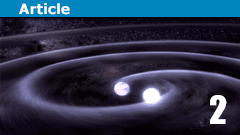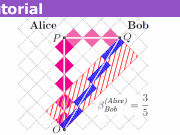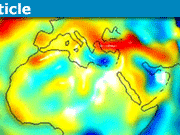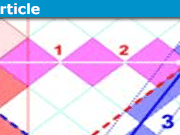Does Gravity Gravitate? Part 2
In the first post of this series, I talked about two ways to answer the title question, one leading to the answer “no” and the other leading to the answer “yes”. However, this will leave a lot of people who ask our title question unsatisfied, because the usual motivations for asking the question have little, if anything, to do with the general points I discussed. In this second post, we’ll look at some particular cases to hopefully shed some more light on the subject.
Consider a massive, gravitating body like the Earth. For simplicity, we’ll assume that the Earth is perfectly spherically symmetric and is not rotating. Then we can describe gravity in the vacuum region outside the Earth using the Schwarzschild metric:
[tex]ds^2 = – \left( 1 – \frac{2M}{r} \right) dt^2 + \frac{1}{1 – 2M / r} dr^2 + r^2 d\Omega^2[/tex]
What is this “##M##” that appears in the line element? Obviously, you say, it’s the mass of the Earth. How do we measure it? Well, we put some small test object into orbit about the Earth and measure the orbital parameters. In other words, ##M## is the “externally measured” mass of the Earth.
This heuristic definition of what ##M## means has been formalized. When we measure orbital parameters, we are really measuring components of the metric and comparing them with the line element given above to see what value of ##M## makes the two match. But the results of such measurements, in any real case, can vary depending on the radius from the central body at which we choose to make measurements. What we would really like is a way of capturing the “effect of mass on the metric” that is independent of such considerations, and there is one. For any spacetime which is asymptotically flat (meaning that the metric becomes the Minkowski metric as the radius from the central body goes to infinity), we can define something called the “ADM mass”:
[tex]M_{ADM} = \frac{1}{16 \pi} \lim_{S \rightarrow i^0} \int_{S} g^{ij} \left( \partial_j g_{ik} – \partial_k g_{ij} \right) n^k dS[/tex]
Here [itex]g_{ij}[/itex] and [itex]g^{ij}[/itex] are the 3-metric and inverse 3-metric on a spacelike slice of “constant time” (where “time” means the time coordinate of the Minkowski metric in the asymptotically flat region), [itex]S[/itex] is a 2-sphere surrounding the central body, and [itex]n^k[/itex] is an outward-pointing unit vector that is normal to the 2-sphere. The limit is taken as [itex]S[/itex] goes to spatial infinity, [itex]i^0[/itex].
For the idealized case of Schwarzschild spacetime, it’s fairly straightforward to show that [itex]M_{ADM} = M[/itex]; that is, the ADM mass as defined above equals the M that appears in the line element. But the ADM mass is applicable to *any* asymptotically flat spacetime, so it applies to objects that aren’t spherically symmetric, like the actual Earth, and to systems containing multiple bodies, like the Solar System or a binary pulsar. (We’ll come back to the latter case below.)
But the ADM mass only depends on the metric coefficients, and those only in the limit of spatial infinity; in other words, it is purely an “external” measure of mass, as we noted above. It would really be nice if we had a way of measuring the mass of the Earth “internally”, by adding up the contributions of all the individual pieces of matter inside the Earth. The “naive” way of doing this is just to integrate the stress-energy tensor over a spacelike slice:
[tex]M_{naive} = \frac{1}{4 \pi} \int dV T_{ab} u^a u^b[/tex]
where [itex]dV[/itex] is the volume element of a spacelike slice of constant time, and [itex]u^a[/itex] is a unit timelike vector that is normal to the spacelike slice.
However, there are two things wrong with this integral. One is that we have just assumed that [itex]T_{ab}[/itex] itself is what belongs in the integrand, without stopping to think about how [itex]T_{ab}[/itex] is actually *related* to the M that appears in the Schwarzschild line element. What we should do, instead, is to look at the Einstein Field Equation, which reads
[tex]G_{ab} = R_{ab} – \frac{1}{2} g_{ab} R = 8 \pi T_{ab}[/tex]
We saw in the previous post that putting [itex]G_{ab}[/itex] on the LHS of this equation is needed in order to ensure that the covariant divergence of both sides is zero. However, we don’t actually *measure* [itex]G_{ab}[/itex] directly. What we actually measure is [itex]R_{ab}[/itex], the Ricci tensor, which directly measures the inward acceleration of a small ball of test particles at a given event due to the stress-energy present at that event. (Note that here we are talking about spacetime events *inside* the Earth, which is where the Ricci tensor is nonzero.) In other words, the Ricci tensor, *not* the stress-energy tensor, is really the best local measure of the “contribution to gravity” of a small piece of matter.
So what we really want for our purposes here is to re-arrange the field equation to put just [itex]R_{ab}[/itex] on the LHS, with the RHS independent of [itex]R_{ab}[/itex] or [itex]R[/itex] (which is the trace of the Ricci tensor). It turns out that this can be done pretty easily; the result is
[tex]R_{ab} = 4 \pi \left( 2 T_{ab} – g_{ab} T \right)[/tex]
where [itex]T[/itex] is the trace of the stress-energy tensor, i.e., [itex]T = T^0{}_0 + T^1{}_1 + T^2{}_2 + T^3{}_3[/itex].
The RHS of this equation is really what should appear in our integral, instead of just [itex]T_{ab}[/itex]. So our next try at the integral looks like this:
[tex]M_0 = \int dV \left( 2 T_{ab} – g_{ab} T \right) u^a u^b[/tex]
However, there is still something wrong. If we compute [itex]M_{0}[/itex] for an object like the Earth, we will get the wrong answer; our answer will be *larger* than the externally measured mass [itex]M[/itex] that appears in the line element. What gives? Well, we forgot one other thing: spacetime is curved. The volume element [itex]dV[/itex] in the above integral is only correct in flat spacetime; in curved spacetime, we have to correct for the fact that the metric varies from place to place. Also, we have to account for the fact that the “rate of time flow” is not constant everywhere, since we are essentially computing an energy (mass and energy are equivalent in relativity) and the “rate of time flow” is therefore involved.
In this particular case, it’s easy to make the corrections because the spacetime is static; I won’t go into detail about this, but the upshot is that we just need to include an extra correction factor in the integral, like so:
[tex]M = \int \sqrt{\xi^a \xi_a} \left( 2 T_{ab} – g_{ab} T \right) u^a u^b dV[/tex]
where ##\xi^a## is the timelike Killing vector field of the spacetime (which must exist because the spacetime is static; in Schwarzschild coordinates the factor ##\sqrt{\xi^a \xi_a}## will just be ##\sqrt{g_{tt}}##). We also have to be careful how we evaluate the volume element ##dV## and the contraction of the 4-velocity ##u^a## with the stress-energy tensor and the metric. I won’t go further into those details here.
If we compute *this* integral for an object like the Earth, we get the correct answer: the ##M## yielded by the integral is the same ##M## that appears in the line element. In fact, what we’ve just done is to compute what’s called the Komar mass of the system. (This mass is defined for a somewhat different class of spacetimes than the ADM mass; where the latter required the spacetime to be asymptotically flat, the Komar mass requires the spacetime to be stationary. This is an important point, but I’ll save further discussion of why it’s important until later on.)
The difference between [itex]M_0[/itex] and [itex]M[/itex] is sometimes referred to as “gravitational binding energy”, and the fact that it is there–that [itex]M_0 – M[/itex] is not zero–is one thing that often prompts people to assert that “gravity gravitates”: that gravity “contributes” to the externally observed mass [itex]M[/itex] of a system. (Personally, I confess that I find this interpretation a bit strange: [itex]M[/itex] is *less* than [itex]M_0[/itex], so the “contribution of gravity” is *negative*. But it’s a common interpretation.) There are a number of caveats to interpreting ##M_0 – M## this way (some of which I intend to discuss in a follow-up post in this series), but as long as the system is not changing with time, it doesn’t really cause any problems. However, when we try to extend this interpretation to systems that *are* changing with time, we run into complications.
First let’s consider an object that is emitting radiation with non-zero stress-energy associated with it, such as EM radiation. What will its externally measured mass look like? There is actually an exact solution called the “Vaidya null dust” for this case, but we won’t need to go into the details of it here; the key point is that if we are orbiting at some finite radius ##r## outside the body, the mass we observe it to have, by measuring our own orbital parameters, will slowly decrease as radiation passes by on its way out to infinity. (“Null dust” means “incoherent EM radiation that, for the purposes of this problem, can be approximated as a spherically symmetric dust–i.e., a “fluid” with zero pressure–of particles–photons–moving radially outward at the speed of light.)
How will this decrease in mass show up in the integrals we looked at above? It turns out that the decrease will *not* show up in the ADM mass at all. This is because the ADM mass involves taking a limit at spatial infinity, and no matter how far the radiation travels from the original body, it will still be at some finite radius; it will never reach spatial infinity. So the ADM mass integral will always “see” it, even though we, at a finite radius ##r##, no longer do.
This issue was recognized quite some time ago, and the solution was fairly straightforward: define an alternative “mass” integral by taking the limit at future null infinity instead of spatial infinity. This is called the Bondi mass, and it allows us to separate out the energy carried by radiation, which escapes to null infinity, from the energy present in what remains behind, the central object. In the case of the Vaidya null dust, the Bondi mass will *not* include the energy carried away by the radiation, so that energy can be quantified as the difference between the ADM mass and the Bondi mass for the spacetime.
What about the case where the radiation being emitted is gravitational waves? We’ll save that for the next post. ;)
- Completed Educational Background: MIT Master’s
- Favorite Area of Science: Relativity








Leave a Reply
Want to join the discussion?Feel free to contribute!